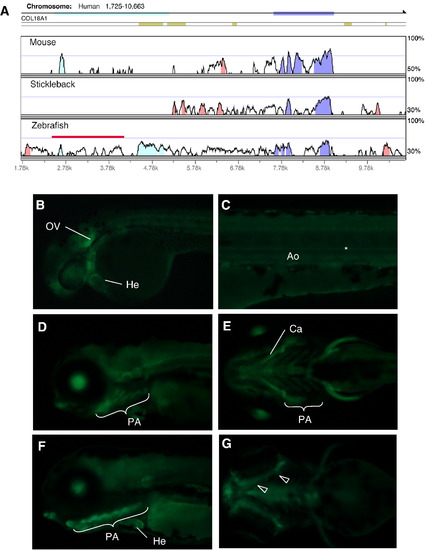Fig. 8
|
Identification of an orthologous zebrafish enhancer sequence showing functional overlap with CNSp +47.8 A) The intergenic sequence of COL18A1 encompassing CNSp +47.8 was compared to orthologous regions from mouse, stickleback, and zebrafish, using Shuffle-Lagan. The turquoise line at top indicates the extent of the human enhancer element, and blue the nearby coding exon, yellow blocks on the second line show the location of repetitive sequences. On the tracks for each species, colored peaks are those meeting the criteria for conservation: turquoise aligning with the enhancer, red with other non-coding sequence, and blue with the exon. The analysis revealed alignment between the human enhancer and zebrafish non-coding sequence; the fragment indicated by the red bar was cloned as described in the text. Note that the larger alignment peak adjacent to the cloned sequenced falls within repetitive sequence in both the human and zebrafish genomes. The zebrafish construct, zCNS +88, regulated EGFP expression in multiple embryonic tissues, including B) heart and otic vesicle; C) aorta and floorplate (asterisk); cartilage (D, E); blood vessels of the pharyngeal arches (E, F); and cranial blood vessels (arrowheads in G). |
Reprinted from Developmental Biology, 337(2), Kague, E., Bessling, S.L., Lee, J., Hu, G., Passos-Bueno, M.R., and Fisher, S., Functionally conserved cis-regulatory elements of COL18A1 identified through zebrafish transgenesis, 496-505, Copyright (2010) with permission from Elsevier. Full text @ Dev. Biol.

